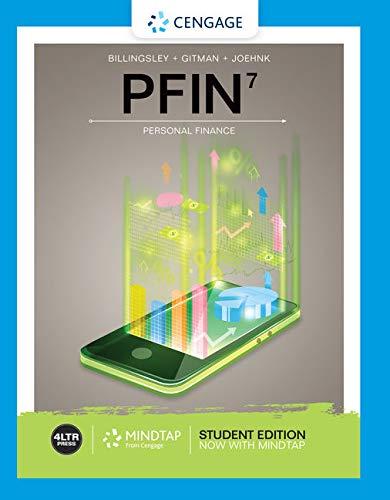
Concept explainers
To determine: The Risk Premium for each factor.
Introduction:
Expected Return is the method of finding the average anticipated probability of several diverse interest rates that are probable on a particular asset. The issues in such persistence comprise of dissimilar
It is also termed as the beta coefficient; it is a method for deciding on the requirement on security or stock that may move in contrast with the market. Risk-free Rate is the he optimal rate on an investment that can be attained deprived of acquiring any risk whereby the stockholder is guaranteed of getting both original principal and a marginal profit during the specified time period. Market Risk Premium is the estimated by initially discovering the expected
Want to see the full answer?
Check out a sample textbook solution
Chapter 12 Solutions
Corporate Finance (The Mcgraw-hill/Irwin Series in Finance, Insurance, and Real Estate)
- I need answer for this question! In which of the following situations would a company most likely issue bonds? A) When it needs to raise short-term capital B) When it wants to increase its working capital C) When it seeks long-term financing D) When it wants to buy back its own sharesarrow_forwardIn which of the following situations would a company most likely issue bonds? A) When it needs to raise short-term capital B) When it wants to increase its working capital C) When it seeks long-term financing D) When it wants to buy back its own sharesarrow_forwardWhat does the term 'liquidity' refer to in finance? A) The ability to quickly convert an asset into cash B) The total value of a company’s assets C) The volatility of a market D) The difference between liabilities and assetsarrow_forward
- Need answer quickly! What does a company’s price-to-earnings (P/E) ratio indicate? A) The return on investment for shareholders B) The company’s profitability relative to its stock price C) The company’s debt relative to its equity D) The company’s dividend payout ratioarrow_forwardDon't use ChatGPT! What does a company’s price-to-earnings (P/E) ratio indicate? A) The return on investment for shareholders B) The company’s profitability relative to its stock price C) The company’s debt relative to its equity D) The company’s dividend payout ratioarrow_forwardWhat does a company’s price-to-earnings (P/E) ratio indicate? A) The return on investment for shareholders B) The company’s profitability relative to its stock price C) The company’s debt relative to its equity D) The company’s dividend payout ratioarrow_forward
- Don't use chatgpt! What is the main purpose of diversification in an investment portfolio? A) To maximize returns B) To reduce risk C) To increase market share D) To monitor stock performancearrow_forwardNo chatgpt! Which type of financial instrument represents a loan made by an investor to a borrower? A) Stock B) Bond C) Derivative D) Optionarrow_forwardWhich of the following is a primary market transaction in finance? A) Buying shares on the stock exchange B) Issuance of new shares by a company C) Trading of bonds D) Purchase of mutual fund unitsarrow_forward
- I need help in this question! What is the main purpose of diversification in an investment portfolio? A) To maximize returns B) To reduce risk C) To increase market share D) To monitor stock performancearrow_forwardWhich type of financial instrument represents a loan made by an investor to a borrower? A) Stock B) Bond C) Derivative D) Optionarrow_forwardNo use ai! Which of the following is NOT a type of derivative in finance?a) Futuresb) Optionsc) Bondsd) Swapsarrow_forward
 EBK CONTEMPORARY FINANCIAL MANAGEMENTFinanceISBN:9781337514835Author:MOYERPublisher:CENGAGE LEARNING - CONSIGNMENT
EBK CONTEMPORARY FINANCIAL MANAGEMENTFinanceISBN:9781337514835Author:MOYERPublisher:CENGAGE LEARNING - CONSIGNMENT Intermediate Financial Management (MindTap Course...FinanceISBN:9781337395083Author:Eugene F. Brigham, Phillip R. DavesPublisher:Cengage Learning
Intermediate Financial Management (MindTap Course...FinanceISBN:9781337395083Author:Eugene F. Brigham, Phillip R. DavesPublisher:Cengage Learning
 Financial Reporting, Financial Statement Analysis...FinanceISBN:9781285190907Author:James M. Wahlen, Stephen P. Baginski, Mark BradshawPublisher:Cengage Learning
Financial Reporting, Financial Statement Analysis...FinanceISBN:9781285190907Author:James M. Wahlen, Stephen P. Baginski, Mark BradshawPublisher:Cengage Learning Pfin (with Mindtap, 1 Term Printed Access Card) (...FinanceISBN:9780357033609Author:Randall Billingsley, Lawrence J. Gitman, Michael D. JoehnkPublisher:Cengage Learning
Pfin (with Mindtap, 1 Term Printed Access Card) (...FinanceISBN:9780357033609Author:Randall Billingsley, Lawrence J. Gitman, Michael D. JoehnkPublisher:Cengage Learning




